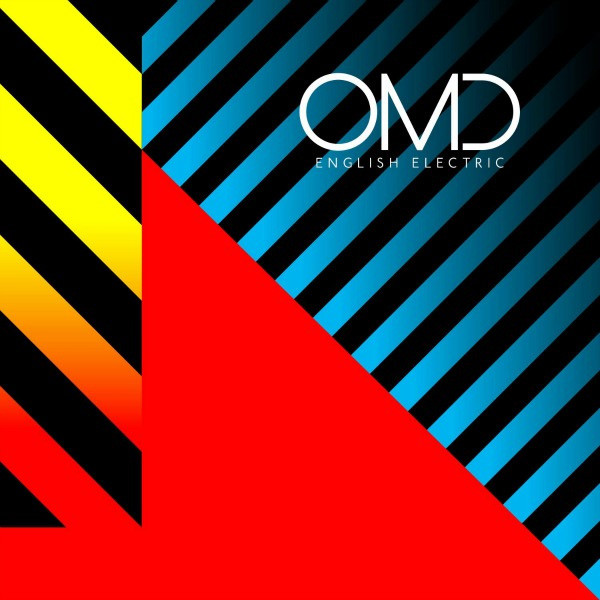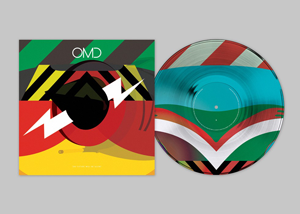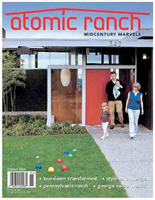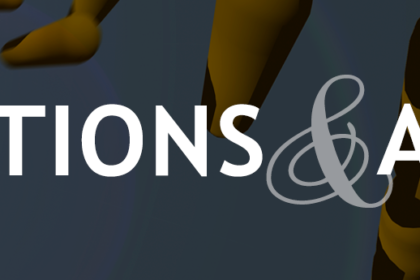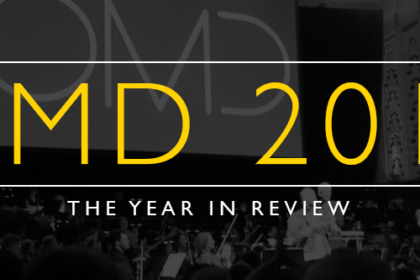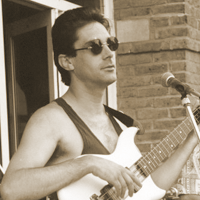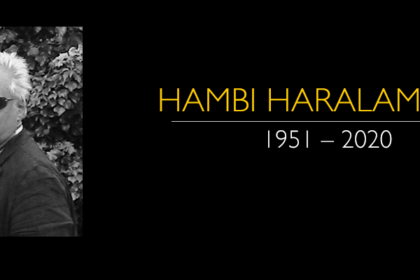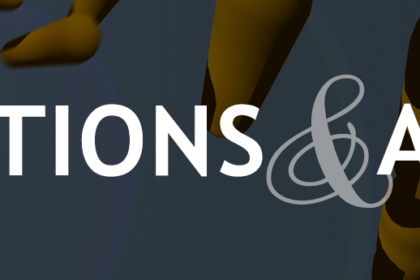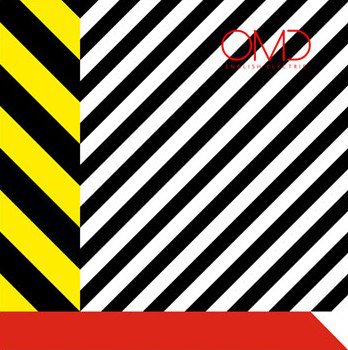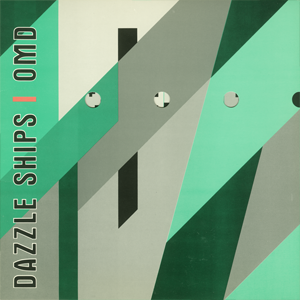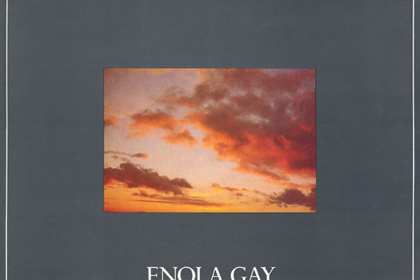What Does The Future Sound Like?
English Electric is OMD’s twelfth studio album and follows on from 2010’s History Of Modern release. The album reached No. 12 on the UK Album Chart and also enjoyed favourable press and critical reviews.
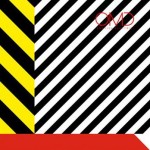 The original leaked sleeve art had a much simpler interpretation which brought to mind the geometric shapes employed by 1983’s Dazzle Ships album. The final sleeve (revealed on the Official OMD Website on 28th January) has been described by Andy as “a variant and more modern interpretation”. The sleeve art is the work of designer Tom Skipp with Peter Saville credited as Executive Art Producer. Commenting on the sleeve, Saville notes: “English Electric is best described as brutally simple dynamic energy… Briefed by OMD to be as reductive as possible, the cover captures but barely contains the hi-tension of an industrial legend.”
The original leaked sleeve art had a much simpler interpretation which brought to mind the geometric shapes employed by 1983’s Dazzle Ships album. The final sleeve (revealed on the Official OMD Website on 28th January) has been described by Andy as “a variant and more modern interpretation”. The sleeve art is the work of designer Tom Skipp with Peter Saville credited as Executive Art Producer. Commenting on the sleeve, Saville notes: “English Electric is best described as brutally simple dynamic energy… Briefed by OMD to be as reductive as possible, the cover captures but barely contains the hi-tension of an industrial legend.”
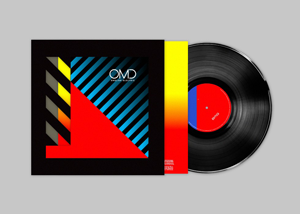
The vinyl edition of English Electric features a die-cut sleeve (recalling OMD’s debut album as well as the sleeves for Architecture & Morality and Dazzle Ships) which reveals the inner sleeve.
English Electric is an album that is said to look at a theme of failed utopian dreams, which often result in dystopic failure and regret. The music is, in part, taking influence from 1983’s Dazzle Ships album which utilised a lot of radio samples, sourced sounds and experimental tracks. Andy McCluskey has also commented that “There are a few tracks that are not ‘songs’. And many of the sounds are more simple and electronic than on History Of Modern”.
During an interview with Andy for Messages back in 2011, he commented further on the genesis of the album: “We were a band that was trying to be the future. That was part of our ethos, that was part of our appeal to a lot of people when they first got interested. They were great tunes. They liked the lyrics, they liked the melodies.. they liked some of the melancholy emotion in the lyrics and everything, but they also liked the fact that we were quite challenging and it was kind of like pushing the envelope. And THAT still remains an issue for us, that we feel like we should be trying to do that”.
Expanding on the direction of sound of the album, Andy has also said: “In terms of the music we had some specific parameters that we wanted to try to stick to. Namely, try to use a more minimal and glitchy sound where we could. Our mantra is ‘what does the future sound like?’. However, there is a natural inclination to be melodic and try to make ‘listenable’ music, not just experiment for its own sake if it does not lead to the creation of something that stands repeated listening.”
For an interview with The Quietus in February of this year, Andy commented on the writing period of the material used on English Electric: “Apart from the complete reworking of ‘Kissing The Machine’, everything on this record has been written in the last two years. ‘Dresden’ and ‘Final Song’ came from pieces of music that I had from the year before, but I hadn’t got a lyric on. I got the lyric on them two years ago, in January 2011. So basically the whole album has been written within the immediate recent timeframe”.
Andy also commented that both Paul Humphreys and himself had viewed English Electric as a “definitive statement” and suggested that they couldn’t view any further OMD albums beyond this one, adding “that’s how good we think it is”.
With this in mind, here’s a breakdown of the information currently known about the tracks for English Electric:
Please Remain Seated
The opening track for the album. A brief excerpt was previewed on the BBC Radio 6 Radcliffe and Maconie show in 2012.
Metroland
 ‘Metroland’ appears to be a return to the lengthier songs of OMD’s past as it clocks in at over 7 minutes. That makes its choice as the first single to be released from the album all the more stranger (presumably a radio edit will be produced). Paul Humphreys summed the song up as “really fantastic”. Andy commented that “‘Metroland’ will be more Radio 6. ‘Dresden’ and ‘Night Cafe’ would be more Radio 2”.
‘Metroland’ appears to be a return to the lengthier songs of OMD’s past as it clocks in at over 7 minutes. That makes its choice as the first single to be released from the album all the more stranger (presumably a radio edit will be produced). Paul Humphreys summed the song up as “really fantastic”. Andy commented that “‘Metroland’ will be more Radio 6. ‘Dresden’ and ‘Night Cafe’ would be more Radio 2”.
The video for ‘Metroland’ is an animated train journey that features nods to the 1984 promo video for OMD’s previous single ‘Locomotion’ and features animated versions of the band themselves. The video was created by design outfit Soup Creative.
In a brief article for Clash Magazine, Andy McCluskey also comments:
“The song is inspired by the early 20th Century London Metropolitan Railway Line campaign slogan to ‘come and live in Metroland’. So many commuters moved from the smoky capital that the very rural idyll they sought was swamped by miles of mock Tudor suburb. The act of reaching for Utopia destroys it.”
The single will be available as either a 12″ vinyl release or as a digital download. The B-side track will be ‘The Great White Silence’.
The single was first aired on the BBC6 Radcliffe and Maconie Show on Monday 11th February.
‘Metroland’ was released on 25th March (and covered in our separate article here: Metroland released).
Night Café
Issued as the third single release from English Electric, Paul Humphreys described this song as “like ‘She’s Leaving’ meets ‘Souvenir'”.
Lyrically, the song appears to have been influenced by Andy McCluskey’s fondness for the works of artist Edward Hopper (the demo versions of the song were titled ‘Hopper 1’ and ‘Hopper 2’), particularly Hopper’s most famous work titled Nighthawks which was painted in 1942 (Interestingly, Hopper’s biographer, Gail Levin, speculated that Hopper may have been inspired by a work by Vincent Van Gogh titled Night Café). The sleeve artwork for the 1985 OMD album Crush was originally to have utilised a Hopper painting, but the fees involved were too high, hence the use of Paul Slater’s appropriation of Hopper’s style for the final sleeve.
The song appears to have been one of the earliest compositions for English Electric and Andy has commented that it “sounds totally different from its original conception”. The construction of the song also appears to be quite complicated as Andy has also mentioned that it would be “challenging” to do live.
Andy has also commented on the song as being “radio friendly”.
The Future Will Be Silent
During the interview for The Quietus in February, Andy revealed a little about the foundations for this song. He had mused on the foundations of many of the samples that had been utilised in previous OMD songs and noted that many of those sounds were simply “audio waste” from machinery and devices. Whereas modern machinery and products are designed to more efficient and so less likely to produce waste noise. “A typewriter is designed to type things onto a page, not make a clicking noise when you hit the key. A steam engine is not designed to go ‘chuff chuff’. That’s an audio waste product of the inefficiency of its engine. And as the world has modernised, the accidental audio by-products, waste products, of the things that have become concrete music are going to be less and less because the designers have designed out the waste so that the machinery of the modern world has actually become more silent. So ‘The Future Will Be Silent’ is actually a reference to that concept”.
To coincide with the annual Record Store Day event on 20th April, a special 10″ EP will be released featuring ‘The Future Will Be Silent’ along with ‘Please Remain Seated’, ‘Decimal’, ‘Atomic Ranch’ and ‘Time Burns’ (a track exclusive to this release).
The EP is a 10″ picture disc in full colour sleeve put together by designer Tom Skipp: “I’ve mixed the English Electric Lightning jet fighter’s distinct nose with the EE Deltic train’s decals. Describing an English Electric modern dream where the future will be silent. The 10″ format is such a great canvas to explore this future with the past”. ‘The Future Will Be Silent’ will be available from participating record outlets on Record Store Day.
Helen of Troy
This track was written by Fotonovela, an electronic outfit consisting of Nik and George from Greek record label Undo Records (also home to Marsheaux, with whom Andy has worked before). Andy has described the song as “’Georgia’ meets first album Depeche”.
In Greek mythology, Helen of Troy (also known as Helen of Sparta) was the daughter of Zeus and Leda, step-daughter of King Tyndareus, wife of Menelaus and sister of Castor, Polydeuces and Clytemnestra. Her abduction by Paris brought about the Trojan War. Commenting on the topic, Andy says “Helen of Troy, is another fascinating character who is hard to really pin down. There are so many different stories and interpretations. Was there actually a real Helen? So a bit like Joan Of Arc, nobody knows but everyone has an angle. Helen Of Troy is for me much more of a lyrical metaphor in the song”.
Our System
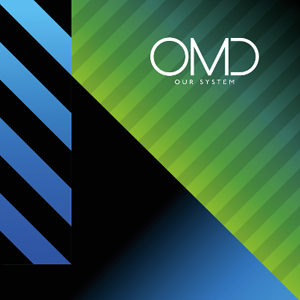 A track inspired by a combination of Glitch and a Stanlow/Romance Of The Telescope-style sound. In the Messages interview with Andy in 2011, he commented that the song “utilises a lot of noises from space probes. Voyager and stuff like that”.
A track inspired by a combination of Glitch and a Stanlow/Romance Of The Telescope-style sound. In the Messages interview with Andy in 2011, he commented that the song “utilises a lot of noises from space probes. Voyager and stuff like that”.
In March 2013, Andy also commented: “‘Our System’ is crafted from a bed track of the sound of the Voyager interplanetary space probe passing through the magnetosphere of Jupiter and lyrically contrasts the perfection of the space craft leaving our solar system against the imperfection of the social system here on earth”. The song’s original working title was ‘Jupiter’ (which is available on the demo CD issued with the Box Set edition of English Electric).
The collectors’ tin boxset of English Electric contains a 7″ single on blue vinyl with ‘Our System’ on the A-side and exclusive track ‘Frontline’ on the B-side.
Kissing The Machine
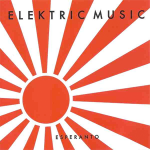 This song was originally a collaboration between Andy McCluskey and Karl Bartos (formerly of Kraftwerk) and appeared on the 1993 album Esperanto by Elektric Music – the musical project that Karl Bartos had created in his post-Kraftwerk period (Andy also shared writing credits on the track ‘Show Business’ for the same album).
This song was originally a collaboration between Andy McCluskey and Karl Bartos (formerly of Kraftwerk) and appeared on the 1993 album Esperanto by Elektric Music – the musical project that Karl Bartos had created in his post-Kraftwerk period (Andy also shared writing credits on the track ‘Show Business’ for the same album).
This wouldn’t be the last collaboration between the pair as Bartos returned the favour by co-writing both ‘The Moon & The Sun’ and also ‘Mathew Street during OMD’s 1996 Universal period.
The version for English Electric is a complete re-recording and reworking of the original song by Paul Humphreys, with only the melody and vocal line remaining the same. This version also features Claudia Brücken as the voice of the machine in both English and German.
Decimal
The first official track from English Electric to get aired in its entirety. Following on from Paul Humphrey’s comments on English Electric as “Dazzle Ships for the 21st Century”, ‘Decimal’ appears to have its roots in the Dazzle Ships track ‘Time Zones’ which was produced from a number of synchronised speaking clock samples from around the world. For ‘Decimal’, the samples appear to have been built from voicemail messages against a minimalist electronic rhythm.
However, anticipating comparisons to Dazzle Ships for the English Electric album, for the interview with The Quietus, Andy McCluskey commented: “I cannot believe that no one actually spotted where ‘Decimal’ comes from. 1975, before Kraftwerk released the Radioactivity [sic] album, and before we’d ever released anything: Einstein On The Beach by Philip Glass. That’s the most obvious reference”.
The video for ‘Decimal’ is the work of a young German animator and graphic designer called Henning M. Lederer.
The animation uses the earlier variation of the English Electric sleeve artwork to ‘bookend’ the video. The design concept of the animation is a variation of one of Lederer’s earlier works from 2003, Net.mation which can be seen here: http://www.led-r-r.net/netmation/netmation.htm
Stay With Me
The original title of this track was ‘Idea 3’ (following on from the History Of Modern-era tracks ‘Idea 1’ and ‘Idea 2’).
Dresden
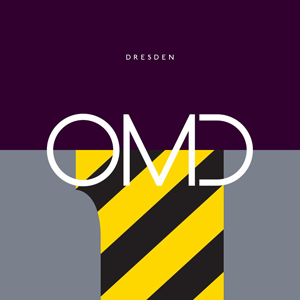
Dresden dates back to 2010 and originally emerged during the History Of Modern sessions. However, the song lacked lyrics at the time so wasn’t considered for the final tracklisting for that album.
Described by Andy McCluskey as “very OMD”, ‘Dresden’ is the follow-up single to ‘Metroland’. Andy also commented on the song as being “radio friendly”.
The single, released on 20th May includes B-side ‘Time Burns’, in addition to remixes by John Foxx And The Maths, Mike Jolly and Bounce Darkside, while the iTunes bundle comes with a reworking by Zebra and Snake.
Dresden is a German city that suffered significant damage during the Second World War after controversial bombing raids by Allied forces.
Atomic Ranch
A track constructed in part with programmed robotic voices. In the interview for Messages back in 2011, Andy talked about the writing of the song: “I got this vox machine app on my laptop and I started putting the words into it and trying out different voices so I’ve now got a vox machine version which is quite cool. It’s all about the sort of utopia of the 50s and 60s that never quite arrived. Where everyone thought they were going to turn into George Jetson and the future would be great and atomic power would solve all our problems and science would fix everything in medicine. This sort of utopian vision that everything was going be great. Of course, in reality, it didn’t turn out that way. So ‘Atomic Ranch’ is about that kind of utopian/dystopian view”.
In 2011, for the website Songwriters On Process, Andy commented further on the inspiration behind the song:
“When I was in America in the early part of this year, I did what I always do when I go: I bought this magazine called Atomic Ranch. It’s about American houses from 1945 to 1970. The classic sort of positive new Utopian lifestyle, with modern furniture and open plan living. I found out that there was a book of the same name. I love it. It’s a metaphor for optimism that everyone had in the 50s and 60s, when the war was over and life would be better, and science and technology would lead us to this Utopian lifestyle where life would be wonderful”.
“So I’m now writing a song called ‘Atomic Ranch’ and the opening line is ‘I want a house and car and a robot wife/I want two kids and a yard and a perfect life.’ But the final line is ‘The future came down like an avalanche/And it fucked the world and my atomic ranch.’ I’ve always been inspired by architecture and interesting buildings. This book and magazine I’ve used the idea as a metaphor for a Utopia that never arrived”.
Andy also suggested that ‘Atomic Ranch’ would come in two parts: one with his vocal and one with the robotic vocals, “I had some time at Easter 2011 and thought that it would be interesting to try putting my lyrics into the app. They turned out so well that I assumed that there would be 2 versions of the song. One computer voice, one with me singing. However, I never really found a track that I felt comfortable singing over”. At this point, the “avalanche” lyric element was also dropped: “The final lyrics just didn’t need saying in the end. Also, the 3 voices created a different dynamic. Particularly, the ‘wife’ voice takes the track to an interesting twist at the conclusion”.
‘Atomic Ranch’ features another animated video by Henning Lederer. This is the second of three animated films that will also be issued as part of the DVD in some versions of the English Electric release.
Final Song
This song dates back to 2010 and originally emerged during the History Of Modern sessions. However, the song lacked lyrics at the time. The song features elements of ‘Lonely House’ – a song originally recorded by American jazz singer Abbey Lincoln (which appears on her 1959 album Abbey Is Blue).
Tracks previously mentioned, but not on the album include:
Frontline
‘Frontline was inspired by the ‘Arab Spring’ uprising of the recent past and was originally titled ‘Artillery’. The rhythm track is composed of gun and artillery fire and concludes with a spoken section on the topic of revolution. The quote about “Those who make peaceful revolution impossible will make violent revolution inevitable” was made by John F Kennedy in 1962.
‘Frontline’ features as the B-side on a special 7″ blue vinyl release of ‘Our System’ included with the tin boxset version of English Electric. It also features as the B-side track on the Night Cafe” single release.
The Great White Silence
B-side to the first English Electric single ‘Metroland’. This song sees a return to the waltz time that was used so effectively on classic OMD song ‘Maid Of Orleans’ and is a track that Andy has described, in the context of OMD’s complete collection of songs, as “probably one of the saddest”.
It also features as the B-side track on the ‘Night Cafe’ single release. This track also appears as a bonus track on the Japanese release of English Electric.
Thank You
This is an old unused OMD song dating from the 1990s which Andy has described as “the most aggressive and angry song that we have ever recorded”. Plans to include this song as a B-side or additional track have since been shelved, as stated by Andy in the Messages interview from March 2013.
No Man’s Land
Another song to emerge from the English Electric sessions. This song will be released as a bonus track on the iTunes release of English Electric.
It also features as the B-side track on the ‘Night Cafe’ single release.
Time Burns
This song is featured on a special 10″ vinyl release titled The Future Will Be Silent EP which is due for release as part of the annual Record Store Day event on 20th April. The EP will also feature ‘The Future Will Be Silent’, ‘Please Remain Seated’, ‘Decimal’ and ‘Atomic Ranch’.
‘Time Burns’ also appears as the B-side to ‘Dresden’, B-side on ‘Night Cafe’ and also as a bonus track on the Japanese release of English Electric.
Kill Me
This was a previously unreleased track which emerged as the B-side to the ‘Night Cafe’ single release.
In September 2013, Andy McCluskey took to OMD’s Facebook page to talk about the evolution of the song: “‘Kill Me’ was actually one of the first ideas that we had for the songs that would form the English Electric collection. I mentioned to Paul that it would be interesting to try a looped vocal idea something like our old song ‘4-Neu’, and suggested the words ‘kill me'”.
“He sent me back the harp arpeggio, chord structure, his own sung chorus and spoken female voice (the first time that I was introduced to the Vox Machina programme). In our usual manner I determined to ‘butcher’ Paul’s sweet track to create the OMD balance of beauty and pain. I introduced the glitchy drums and my lyrics began as purely dark”.
“However, as time elapsed the focus of the lyric became more uplifting. It tells of a journey through pain and darkness to another brighter light. The ‘kill me’ phrase is rather cathartic now, referring to sloughing off an old skin (killing the past or ones former self) and starting again”.
“It seems appropriate that we close this chapter of Orchestral Manoeuvres in the Dark with this beautiful song. There is a wonderful future if you choose it: we just do not know where it will lead us”.
Shelter (The xx cover)
In an exclusive interview with our sister site The Electricity Club in 2011, Andy discussed OMD’s cover versions of indie pop outfit the xx. “The record company thought it would be very cool to ask The xx to do a mix for us. Of course, everybody and their dog last year wanted The xx to do a mix for them. The NME were planning to do a covers compilation album of The xx’s songs so the band said ‘if you cover one of our songs, we’ll do a mix for you’ in a reciprocal deal. We did ‘VCR’ which I loved playing the bass on and then they went ‘Oh God, not ‘VCR’… everyone’s doing ‘VCR’!’ so we did ‘Shelter’. So that’s why we did two of their songs, but the album never happened”.
‘VCR’ appeared as the B-side to ‘History Of Modern (Part 1)’ while ‘Shelter’ was unreleased. Commented on the unreleased song Andy said “I think ‘Shelter’ is even better than ‘VCR’! It beautiful because it’s got that suspended choir chord that sounds like Kraftwerk and the piano”. Andy added “‘Shelter’, we have got up our sleeves for future reference to tease people with… ‘VCR’s good but ‘Shelter’s f*cking gorgeous!”.
Apparently the original track listing for the album was much longer, but a decision was taken to trim the album running time back by removing 2 songs.
English Electric also sees OMD declining the use of an outside producer for the album with both Andy McCluskey and Paul Humphreys producing and Paul Humphreys mixing for this OMD outing. The album was also recorded at The Motor Museum in Liverpool and at Bleepworks, London.
In terms of the equipment that OMD are using on the new album, the list breaks down as follows:
Paul Humphreys: Synth-Werk, ARP 2600, M Tron Pro, Trillion, Omnisphere, Oberheim SEM V, Morphoder, Jupiter 8V2, Minimoog V, Prophet Pro 53, Massive, Vacuum, Boom
Andy McCluskey: Vacuum, Indigo Virus, M Tron Pro, Jupiter 8, Vox Machina
OMD have also now signed a worldwide deal with BGM for English Electric, which will also see the company acquire much of OMD’s publishing back catalogue as part of a proposed purchase of the Virgin Music Publishing catalogue.
English Electric was released on 8th April 2013. The album is available to order from the Official OMD Website here: http://omd.firebrandstore.com/
Messages extends its thanks to Andy McCluskey.
The Messages review of the album is here: English Electric – The Messages Review
Official OMD Website: www.omd.uk.com

